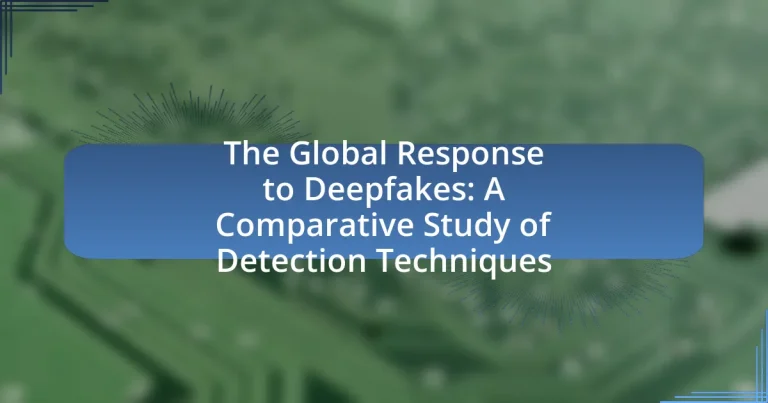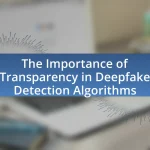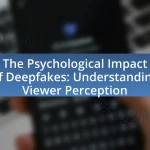Deepfakes are synthetic media generated through artificial intelligence that can distort audio and video, raising significant concerns regarding misinformation, reputation damage, and societal trust. This article examines the global response to deepfakes, focusing on detection techniques, regulatory measures, and the roles of governments and tech companies in combating this issue. It highlights the creation process of deepfakes, their applications across various sectors, and the risks they pose to personal privacy and public discourse. Additionally, the article discusses the effectiveness of current detection methods, the challenges faced in addressing deepfakes, and best practices for individuals and organizations to mitigate their impact.

What are Deepfakes and Why are They a Concern?
Deepfakes are synthetic media created using artificial intelligence that can manipulate audio and video to make it appear as though someone is saying or doing something they did not actually say or do. They are a concern because they can be used to spread misinformation, damage reputations, and undermine trust in media, as evidenced by incidents where deepfakes have been employed in political campaigns and social media to mislead the public. The potential for deepfakes to disrupt societal norms and influence public opinion highlights the urgent need for effective detection techniques and regulatory measures.
How are Deepfakes created?
Deepfakes are created using artificial intelligence techniques, primarily through deep learning algorithms that manipulate audio and visual data. These algorithms, particularly Generative Adversarial Networks (GANs), consist of two neural networks: a generator that creates fake content and a discriminator that evaluates its authenticity. The generator learns from a dataset of real images or videos of a target individual, while the discriminator assesses the generated content against real examples, iteratively improving the quality of the deepfake until it becomes indistinguishable from genuine media. This process has been validated by numerous studies, including research published in the journal “Nature” by Karras et al., which demonstrates the effectiveness of GANs in generating high-fidelity images.
What technologies are used in the creation of Deepfakes?
Deepfakes are primarily created using artificial intelligence technologies, specifically deep learning techniques such as Generative Adversarial Networks (GANs). GANs consist of two neural networks, a generator and a discriminator, that work against each other to produce realistic synthetic media. The generator creates fake images or videos, while the discriminator evaluates them against real data, improving the quality of the output over time. Additionally, techniques like autoencoders and convolutional neural networks (CNNs) are also employed to enhance the realism and accuracy of the generated content. These technologies enable the manipulation of visual and audio data, resulting in highly convincing deepfake media.
What are the common applications of Deepfakes?
Common applications of deepfakes include entertainment, education, and advertising. In entertainment, deepfakes are used to create realistic visual effects in films and to generate content for social media platforms, enhancing viewer engagement. In education, they serve as tools for creating immersive learning experiences, such as historical reenactments or language learning aids. In advertising, brands utilize deepfake technology to produce personalized marketing content, allowing for tailored advertisements that resonate with specific audiences. These applications demonstrate the versatility of deepfakes across various industries, leveraging advanced AI techniques to enhance user experience and engagement.
What risks do Deepfakes pose to society?
Deepfakes pose significant risks to society, primarily by undermining trust in media and information. The ability to create hyper-realistic fake videos can lead to misinformation, manipulation of public opinion, and damage to reputations. For instance, a study by the University of California, Berkeley, found that deepfake technology can be used to create misleading political content, which can influence elections and public discourse. Additionally, deepfakes can facilitate harassment and defamation, as seen in cases where individuals have been targeted with non-consensual explicit content. The potential for deepfakes to disrupt social cohesion and incite violence further underscores their societal risks.
How can Deepfakes impact personal privacy?
Deepfakes can significantly impact personal privacy by enabling the creation of realistic but fabricated videos or audio recordings that can misrepresent individuals. This technology can be used maliciously to create non-consensual explicit content, spread misinformation, or damage reputations, leading to emotional distress and potential legal consequences for the victims. For instance, a study by the University of California, Berkeley, found that deepfake technology could be used to create misleading political content, which poses risks to public trust and individual privacy. The ability to manipulate visual and auditory information undermines the authenticity of personal identity, making it challenging for individuals to control their own image and voice in the digital landscape.
What are the implications of Deepfakes in misinformation?
Deepfakes significantly exacerbate misinformation by creating highly convincing yet fabricated audio and visual content that can mislead audiences. This technology enables the manipulation of public perception, as seen in instances where deepfakes have been used to impersonate political figures, leading to confusion and distrust among the electorate. Research indicates that 96% of deepfake videos are pornographic, but the remaining 4% can have serious implications for political discourse and social stability, as they can be weaponized to spread false narratives or discredit individuals. The rapid advancement of deepfake technology outpaces the development of detection methods, making it increasingly challenging for platforms and users to discern truth from deception.

How is the Global Community Responding to Deepfakes?
The global community is responding to deepfakes through a combination of regulatory measures, technological advancements, and public awareness initiatives. Governments in various countries are implementing laws aimed at combating the misuse of deepfake technology; for instance, the United States has introduced legislation that criminalizes the malicious use of deepfakes, particularly in contexts like election interference and non-consensual pornography. Additionally, tech companies are developing sophisticated detection tools to identify deepfakes, such as Facebook’s Deepfake Detection Challenge, which encourages researchers to create algorithms that can effectively spot manipulated media. Furthermore, organizations and educational institutions are conducting awareness campaigns to inform the public about the risks associated with deepfakes, emphasizing the importance of media literacy in the digital age. These collective efforts illustrate a proactive stance by the global community to address the challenges posed by deepfake technology.
What measures are being taken to combat Deepfakes?
Governments and organizations are implementing various measures to combat deepfakes, including the development of advanced detection technologies and legislative frameworks. For instance, researchers are utilizing machine learning algorithms to identify inconsistencies in videos, such as unnatural facial movements or audio mismatches, which are common in deepfakes. Additionally, countries like the United States have introduced laws aimed at penalizing the malicious use of deepfakes, particularly in contexts like election interference and harassment. These measures are supported by studies showing that detection tools can achieve over 90% accuracy in identifying manipulated content, reinforcing the effectiveness of these initiatives.
What role do governments play in regulating Deepfakes?
Governments play a crucial role in regulating deepfakes by establishing legal frameworks and guidelines to address the potential harms associated with this technology. For instance, various countries have enacted laws targeting the malicious use of deepfakes, such as California’s AB 730, which criminalizes the use of deepfakes for malicious purposes, including defamation and fraud. Additionally, governments collaborate with technology companies and researchers to develop detection techniques and promote public awareness about the risks of deepfakes. This regulatory approach aims to balance innovation with the protection of individuals and society from misinformation and manipulation.
How are tech companies contributing to the fight against Deepfakes?
Tech companies are contributing to the fight against deepfakes by developing advanced detection technologies and collaborating on industry standards. For instance, Google has introduced the “Asynchronous Deepfake Detection” tool, which utilizes machine learning algorithms to identify manipulated media. Additionally, Facebook has partnered with academic institutions to create the Deepfake Detection Challenge, incentivizing researchers to improve detection methods. These initiatives demonstrate a commitment to combating misinformation and enhancing the integrity of digital content.
What are the challenges in addressing Deepfakes globally?
Addressing deepfakes globally presents significant challenges, primarily due to the rapid advancement of technology that outpaces regulatory frameworks. The difficulty in creating effective detection methods stems from the evolving sophistication of deepfake algorithms, which can produce highly realistic content that is hard to distinguish from genuine media. Additionally, the lack of international consensus on legal definitions and regulations complicates enforcement efforts, as different countries have varying laws regarding misinformation and digital content. Furthermore, the anonymity provided by the internet allows malicious actors to exploit deepfakes for disinformation campaigns without accountability, making it challenging to trace and mitigate their impact. These factors collectively hinder a cohesive global response to the deepfake phenomenon.
How do legal frameworks vary across countries regarding Deepfakes?
Legal frameworks regarding deepfakes vary significantly across countries, with some nations implementing specific laws while others rely on existing regulations. For instance, the United States has seen states like California and Texas enact laws targeting deepfakes, focusing on issues such as consent and defamation, while federal legislation is still under discussion. In contrast, the European Union is working on comprehensive regulations that address deepfakes within the broader context of digital content and misinformation, emphasizing accountability for platforms. Countries like China have also introduced strict regulations that criminalize the malicious use of deepfakes, reflecting a more authoritarian approach to content control. These variations illustrate how cultural, political, and legal contexts shape the response to deepfakes globally.
What are the limitations of current detection technologies?
Current detection technologies for deepfakes face several limitations, including high false positive rates, difficulty in detecting novel manipulation techniques, and reliance on large datasets for training. High false positive rates can lead to misidentification of genuine content as manipulated, undermining trust in detection systems. Additionally, as deepfake technology evolves, existing detection methods struggle to keep pace with new manipulation techniques, resulting in decreased effectiveness. Furthermore, many detection algorithms require extensive training on diverse datasets, which may not always be available, limiting their applicability across different contexts and types of deepfakes.

What Detection Techniques are Being Developed and Used?
Detection techniques being developed and used to combat deepfakes include machine learning algorithms, digital forensics, and blockchain technology. Machine learning algorithms, particularly convolutional neural networks (CNNs), are trained on large datasets of authentic and manipulated media to identify inconsistencies in visual and audio content. Digital forensics techniques analyze metadata and pixel-level anomalies to detect alterations in media files. Blockchain technology is being explored for its potential to verify the authenticity of original content through immutable records. These methods are supported by research indicating their effectiveness; for instance, a study published in the IEEE Transactions on Information Forensics and Security demonstrated that CNNs could achieve over 90% accuracy in detecting deepfake videos.
What are the most common detection techniques for Deepfakes?
The most common detection techniques for Deepfakes include machine learning algorithms, visual artifacts analysis, and biometric analysis. Machine learning algorithms, particularly convolutional neural networks (CNNs), are trained on large datasets of real and fake videos to identify subtle inconsistencies. Visual artifacts analysis focuses on detecting anomalies in lighting, shadows, and facial movements that are often present in Deepfakes but not in genuine videos. Biometric analysis examines features such as eye blinking patterns and facial expressions, which can reveal discrepancies between the synthetic and authentic content. These techniques have been validated through various studies, demonstrating their effectiveness in distinguishing between real and manipulated media.
How does machine learning enhance Deepfake detection?
Machine learning enhances Deepfake detection by utilizing algorithms that can analyze and identify patterns in video and audio data that are indicative of manipulation. These algorithms, such as convolutional neural networks (CNNs), are trained on large datasets of both authentic and Deepfake content, allowing them to learn the subtle differences that may not be immediately apparent to human observers. Research has shown that machine learning models can achieve accuracy rates exceeding 90% in distinguishing between real and fake media, as demonstrated in studies like “Deepfake Detection: A Survey” published in IEEE Access, which highlights the effectiveness of various machine learning techniques in this domain.
What role does blockchain technology play in verifying content authenticity?
Blockchain technology plays a crucial role in verifying content authenticity by providing a decentralized and immutable ledger that records the provenance of digital content. This technology ensures that once data is recorded, it cannot be altered or deleted, which helps in establishing a verifiable history of content creation and modifications. For instance, when a piece of content is created, its unique hash can be stored on the blockchain along with metadata such as the creator’s identity and timestamp. This allows users to trace the content back to its original source and confirm its authenticity. Research indicates that blockchain can significantly reduce the risk of misinformation and deepfakes by enabling transparent verification processes, as seen in projects like the Mediachain initiative, which aims to track and verify digital media ownership and authenticity.
How effective are current detection techniques?
Current detection techniques for deepfakes are moderately effective, with accuracy rates varying between 65% to 90% depending on the method used. For instance, machine learning algorithms, particularly convolutional neural networks, have shown promising results in identifying manipulated media, achieving accuracy levels around 86% in controlled environments. However, their effectiveness diminishes in real-world scenarios due to the rapid evolution of deepfake technology, which continuously adapts to evade detection. Studies, such as those conducted by the University of California, Berkeley, highlight that while detection tools are improving, they still struggle against high-quality deepfakes that utilize advanced techniques like generative adversarial networks (GANs).
What are the success rates of various detection methods?
The success rates of various detection methods for deepfakes vary significantly, with some techniques achieving accuracy rates above 90%. For instance, deep learning-based methods, such as convolutional neural networks (CNNs), have demonstrated success rates ranging from 85% to 98% in identifying manipulated videos. Research conducted by Korshunov and Marcel in 2018 found that their CNN-based approach achieved an accuracy of 97% on a dataset of deepfake videos. Additionally, traditional methods, such as pixel-based analysis, tend to have lower success rates, often falling below 70%. These statistics highlight the effectiveness of advanced machine learning techniques in detecting deepfakes compared to more conventional methods.
How do detection techniques evolve with advancing Deepfake technology?
Detection techniques evolve in response to advancements in Deepfake technology by incorporating more sophisticated algorithms and machine learning models. As Deepfake methods become increasingly complex, detection systems utilize deep learning approaches, such as convolutional neural networks (CNNs), to analyze visual and auditory inconsistencies in media. For instance, researchers have developed techniques that focus on identifying artifacts in the pixel distribution or analyzing facial movements that deviate from natural human behavior. Studies, such as those published in the IEEE Transactions on Information Forensics and Security, demonstrate that as Deepfake generation techniques improve, detection methods must also adapt, often employing ensemble learning and adversarial training to enhance accuracy and robustness against new Deepfake variants.
What best practices can be adopted to mitigate the impact of Deepfakes?
To mitigate the impact of Deepfakes, organizations should implement a multi-faceted approach that includes technological solutions, public awareness campaigns, and regulatory frameworks. Technological solutions involve utilizing advanced detection algorithms that analyze inconsistencies in video and audio content, as demonstrated by research from the University of California, Berkeley, which developed a system that can identify Deepfakes with over 90% accuracy. Public awareness campaigns educate individuals about the existence and risks of Deepfakes, fostering critical thinking and skepticism towards media consumption. Regulatory frameworks can establish legal consequences for malicious use of Deepfakes, as seen in countries like the United States, where some states have enacted laws specifically targeting the malicious creation and distribution of Deepfake content. Together, these best practices create a comprehensive strategy to address the challenges posed by Deepfakes.
How can individuals protect themselves from Deepfake-related risks?
Individuals can protect themselves from Deepfake-related risks by verifying the authenticity of media before sharing or believing it. This can be achieved through cross-referencing information with trusted sources, using reverse image searches, and employing specialized detection tools designed to identify manipulated content. Research indicates that awareness and education about Deepfakes significantly reduce susceptibility to misinformation, as individuals who are informed about the technology are more likely to question suspicious media.
What strategies can organizations implement to combat Deepfakes?
Organizations can implement several strategies to combat Deepfakes, including investing in advanced detection technologies, establishing clear policies and guidelines, and promoting digital literacy among employees and the public. Advanced detection technologies, such as machine learning algorithms and blockchain verification, can help identify manipulated content effectively. Clear policies and guidelines ensure that employees understand the risks associated with Deepfakes and the protocols for reporting suspicious content. Furthermore, promoting digital literacy equips individuals with the skills to critically evaluate media, reducing the likelihood of misinformation spreading. These strategies collectively enhance an organization’s resilience against the threats posed by Deepfakes.


